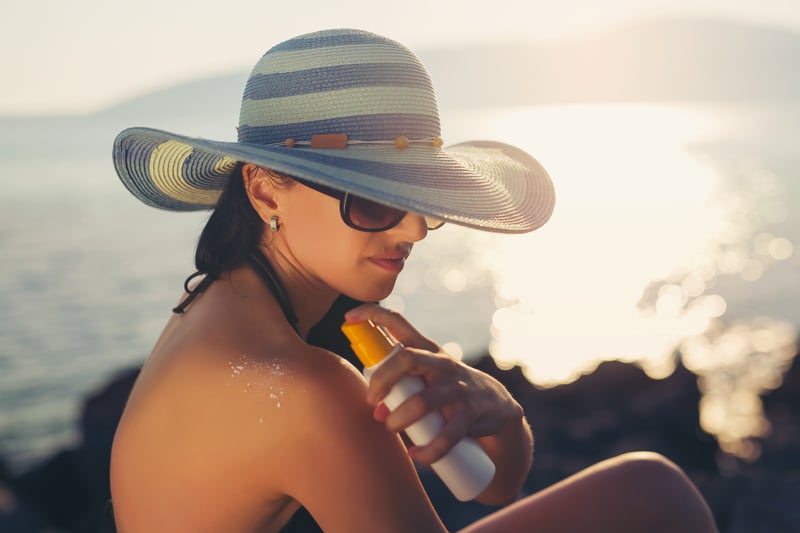Fake Tan vs. Real Tan: Which Is Better for You?

Even with our knowledge of the dangers of excess sun exposure, our society still seems to covet the look of a warm, glowing tan. Especially in summer months, many of us seek a darker, richer color to eliminate “pasty white” winter skin. And to temporally look like a bronze god or goddess, some are even willing to increase health risks. Fortunately, we now have more options for getting that glow, but in the battle between a fake tan vs. real tan, which is better?
Real Tan Benefits and Risks
In addition to being considered attractive and fashionable, tanned skin is often looked at as a sign of good health. Yet we know from science that excess exposure to UV light via natural sunshine or tanning booths damages the skin, causing it to age prematurely and increase the risk of skin cancer, especially if that time under the sun or sunlamp leads to sunburn. In fact, a single sunburn that causes blistering can double the risk of melanoma.
The most common types of skin cancers are basal cell carcinoma and squamous cell carcinoma. Fortunately, they’re usually curable as long as they’re discovered and treated early. The most dangerous type of skin cancer is melanoma. Nearly 5 million Americans will be treated for skin cancer this year, which is a 50% increase from a decade ago at twice the cost ($8 billion) from 10 years ago.
According to The Skin Cancer Foundation, there’s no such thing as a safe, healthy tan caused by prolonged exposure to UV (ultraviolet) radiation from the sun or sun lamp, both of which emit two types of UV rays—UVA and UVB. UVA rays are longer in wavelength, and they’re typically associated with aging skin. UVB rays have shorter wavelengths and are the ones that lead to sunburns. Both can damage the skin with prolonged, unprotected exposure over time. 1 Other risks of natural tanning include dehydration and overheating.
There are also times when you need to be more careful. For instance, the skin can become more prone to burns (i.e., photosensitive) due to hormonal fluctuations, such as pregnancy, or with the use of certain medications or skincare products. This can increase the risk of burns, rashes, or irregular pigmentation (like sunspots). And during certain times of the day (i.e., between 10:00 am and 4:00 pm), the UV rays are stronger, and thus, the sun exposure is more damaging.
Simple ways to protect the skin and still enjoy the outdoors include using a broad-spectrum sunscreen with at least 30 SPF, wearing sun-safe, wide-brimmed hats, and donning sun-protective clothing and eyewear. It can also help to protect the skin when you’re indoors by adding UV window film to home and car windows.
There are, of course, benefits to sunlight as well, including decreased inflammation, lowered blood pressure, stronger bones, better sleep, healthier immune functioning, vitamin D creation, and more. The goal is to get enough—but not too much—sunlight. And that right amount likely won’t lead to much of, if any, tan. And it doesn’t address what to do if you have a ghostly completion.
Enter, sunless or “fake” tans.
Sunless, Fake, or Faux Tanning Benefits and Risks
With the growing prevalence of skin cancer (and the growing costs of treatment) and our national obsession with wrinkle and sunspot prevention, many are wondering if there isn’t a better option. Sunless tanning options—including self-tanning drops, gels, lotions, foam, and spray tans—allow you to achieve the look of a suntan without ultraviolet radiation exposure. 2,3 If you want to enjoy a summer glow, these options are considered significantly safer than suntans. But they aren’t completely risk-free.
Self-tanners typically produce the golden tan with a compound known as DHA or dihydroxyacetone. This chemical doesn’t stain the skin. Rather, it’s a colorless compound that causes a chemical reaction between the proteins in the top layers of the skin and the sugars in DHA. This reaction forms a darker protein that’s bound to the top layer of skin. This leaves a temporary tan that doesn’t immediately wash off, though it can discolor clothing or sheets if they come in contact with the newly tanned skin. These sunless tans can last between seven and ten days before they need to be reapplied.
Compared to sunbathing, sunless tans have some good benefits beyond giving your skin a warm, healthy glow as if you’ve been relaxing on the beach. The most obvious is that you avoid the skin damage from the radiation of the sun or tanning beds. That is, they don’t increase the risks of sunburns or skin cancers like melanomas. They also don’t weaken the skin’s resiliency, which leads to fine lines and wrinkles, telltale signs of sun damage.
DHA has been found by the FDA to be safe when used topically. Research indicates, for example, that DHA isn’t absorbed by the skin. That is, with topical use, DHA was not detected in the blood or urine.
There are some cons of fake tanning, though. Some tanning products (i.e., spray tans) are delivered via aerosol. And DHA has been found to be irritating to mucous membranes, such as those found in the nose, lips, and lungs. We also don’t yet know what the long-term effects of spray tans will have on the body. In general, DHA should not be inhaled or ingested. It’s also important to protect any areas that are covered by mucous membranes, such as the lips, nose, ears, and eye area, by wearing googles, lip production, nose and ear plugs during the spray tanning process. 4
Other ingredients to watch for in fake tanning products are added fragrances and other additives. While these may make the smell more pleasant or make the product easier to apply, fragrances and other chemicals can irritate the skin and mucous membranes. People with sensitive skin (e.g., people with eczema, psoriasis, etc.) should test their skin on a small patch, such as behind the ear, on the stomach, or on the inner thigh, before using the product on the rest of the skin to make sure it doesn’t lead to an uncomfortable reaction. Fake tanning products should also not be applied to damaged or aggravated skin.
One of the biggest risks of fake tans is the belief that a tan, of any type, helps protect the skin from aging or sunburn. So, people head outside without sufficient protection and get burned. Not only does the fake tan offer 0 SPF, but it can actually make the skin more sensitive to sun damage, such as collagen and elastin breakdown, which can make the skin age faster.
Fake Tan vs. Real Tan: Which is Better?
In a perfect world, we could simply love the skin we’re in—no matter the shade. However, many of us do prefer how we look with a bit more color, especially in the summer months. If you resemble that comment, then a fake tan vs. real tan is the better option.
If you do decide to get a sunless tan, there are some important dos and don’ts:
• Start with a lighter tan—you can always go darker in the future.
• Choose a quality product. If you have sensitive skin, you can find organic, vegan, hypoallergenic versions. You will, however, still want to do a test on a small patch of skin.
• Before you apply the tan, shave and exfoliate your skin and wash off any creams or topicals (e.g., deodorant or lotion), so you start with a clean, smooth surface.
• Dry the skin completely, so the chosen self-tanner spreads evenly.
• Remember to wash your hands with soap and water after applying each section to avoid having orange-colored palms. It can also help to wear mitts to apply the self-tanner or apply a thick cream barrier onto your hands before beginning to apply the product.
• Apply the self-tanner in sections (e.g., start with the arms, then cover the legs, and then hit the torso), massaging the tanner in completely in a circular motion. Take extra care to blend around the joints by using less product (e.g., dilute it with a layer of lotion or oil or rub lightly with a damp towel to remove excess product) around the knees, ankles, elbows, and wrists. Likewise, remember that dry skin will draw in more product, so be aware of any dry cuticles, elbows, and heels before applying as they can absorb more DHA and thus make that skin look darker.
• Allow plenty of time for your skin to fully dry—at least 10 minutes—before you get dressed. For the next several hours, wear only comfy, loose-fitting clothing that doesn’t rub, and avoid sweating if possible.
• After getting a fake tan, remember to stay hydrated and moisturize your skin every day.
• To help extend your tan, use recommended aftercare products.
• If you’re going into water (such as a lake, pool, or ocean), rinse off well when you get out, so the salt or chemicals don’t fade your sunless tan.
• Most important of all: Remember to use a broad-spectrum sunscreen of 30 or more SPF when in the sun. Contrary to popular belief, a natural tan only adds an SPF of around 3 to 4 and a sunless tan offers no sun protection at all. 5





 US Doctor: "Eating This Every Day Can Snap You Into Ketosis"
US Doctor: "Eating This Every Day Can Snap You Into Ketosis" 3 Key Nutrients to Help Lubricate Your "Tin Man" Joints
3 Key Nutrients to Help Lubricate Your "Tin Man" Joints AVOID Plant-Based Protein Powders (unless...)
AVOID Plant-Based Protein Powders (unless...)

